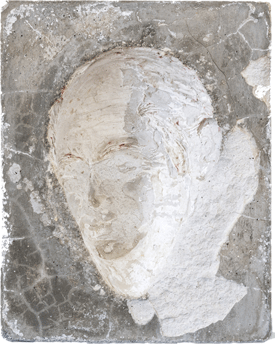11.15.23 — Other than Sculpture
Sometimes I worry that SculptureCenter has lost track of its mission. It may never be a center of the action, close as it is to the long-overdue resurgence of Long Island City. Often as not, though, its contents have little to do with sculpture, rather than video or conceptual art.
Now Tania Pérez Córdova gets real. She is, says the center, “using materials that are historically related to sculptural practices—like metal, ceramics, plastic glass, and marble.” She does, that is, not counting bird droppings, makeup, cigarette stubs, and human hair. One may have to get up close at that to sense a disturbance, apart from one small thing:  that sculptural mass may itself seem left over from a work crew or artist’s studio. Clumps of marble may end up in the trash, too. Could they then have a second life as art?
that sculptural mass may itself seem left over from a work crew or artist’s studio. Clumps of marble may end up in the trash, too. Could they then have a second life as art?
If something other than sculpture is all that remains, through December 11, you can understand. The site itself, a former trolley repair shop and its basement tunnels, is too much for many an artist to resist. Julian Abraham “Togar,” as he calls himself, converts them into his OK Studio, a place to make music. He lays out instruments for a full band, with messages on the walls assuring you of his good intentions. (In Case of Emergency / Call Me by Your Name.) He personally rocks out on video by the sea or by a stoop, drumming and chiming away.
Drummer’s Gonna Drum, Togar’s titles read, and Rocker’s Gonna Rock, but what about sculpture? Has it grown superfluous for those who can look around them and see? Marina Xenofontos calls herself a sculptor, on the slim basis of small cylinders rotating more slowly than the eye can see and deck chairs from a cruise to her native Crete. Devin L. Mays simply shovels pebbles from the often-empty sculpture garden up against the far wall, so that its mass becomes more than halfway sculptural itself. Someone should have thought of that just up the street at MoMA PS1, where the courtyard devolved into a pebbled wasteland with concrete walls from the moment it appeared. And then there is Córdova, in sculptural practice.
Practice makes imperfect, but one does have to get up close to see much out of the ordinary. On inspection, that black marble serves as little more than an ashtray for the bird droppings, makeup, and cigarette. Up close, too, shampoo bubbles up from a vinyl container, the kind often used for spackle or cement, like crystalline sculpture. As a further twist, that container is itself a replica, of itself. Córdova molded it, melted it down, and poured the results into her mold before adding bubbles. She began the series with a found trumpet, and it continues with a fragment of corrugated aluminum roofing on the building out front.
The Mexican artist is playing around with the industrial, like Minimalism, and the replica, like Postmodernism. She is playing, too, with solid objects and “negative spaces,” like Rachel Whiteread casting entire buildings. Mays plays around with the familiar, too, when he throws in shipping pallets, with a poncho for an element of color, although it dilutes the creativity of his shoveled stone. It could pass for debris left over from installation a little too well. Córdova has also cast in bronze the design of larger spaces, public or private, like urban squares and rooms, for what look like Rococo picture frames. They, too, may not quite come off, but the puzzle of here and elsewhere, positive and negative, continues.
It does, too, when another tub holds artificial saliva. She is spitting on fine art, unless it was not quite spit and not so pretentiously fine. She recasts as well the partition that divides the exhibition space from the front desk. Or rather, she replaces it with anti-hail mesh (whatever that is), littered with “industrially destroyed private information.” She is again questioning public and private, but also speech and memory. The saliva fell from a speech of (she promises) fifty-two hundred words, and a performance just once during the show’s run, In Other News, rewrites the headlines.
The flip side of communication is perception, and a larger, veined marble holds contact lenses, “of color different from human eyes.” And the flip side of both is physical presence and bodily sensation. Córdova’s single most sculptural work casts faces, as repositories for ice. As it melts, they reassert their ghostly impression, but so does the artist in replenishing it so that it can continue melting. So many bodies of work may leave a lesser impression, but all sensation has its limits. The polka dots on a black vase are An Unknown Person Passing By.
Read more, now in a feature-length article on this site.